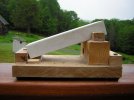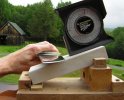- Joined
- Jun 4, 2010
- Messages
- 6,642
Heck Fred, you can teach someone a straight punch, reverse palm, front kick and a little blocking and footwork in one afternoon. Sure enough if they don't practice they will never be able to use even that, but if they do, their odds of surviving in a brawl have been improved tremendously. My daughter is 7 and already picking up hand wraps and some Chin Na. The better fighters stick to the basics anyway, and some of the best brawlers don't execute with textbook form in any discipline.
Most folk only sharpen for themselves, the basics will work just fine and as a springboard for further improvement if desired. As long as one understands why things are happening the way they are, unacceptable outcomes can be reduced quite a bit.
Most folk only sharpen for themselves, the basics will work just fine and as a springboard for further improvement if desired. As long as one understands why things are happening the way they are, unacceptable outcomes can be reduced quite a bit.


